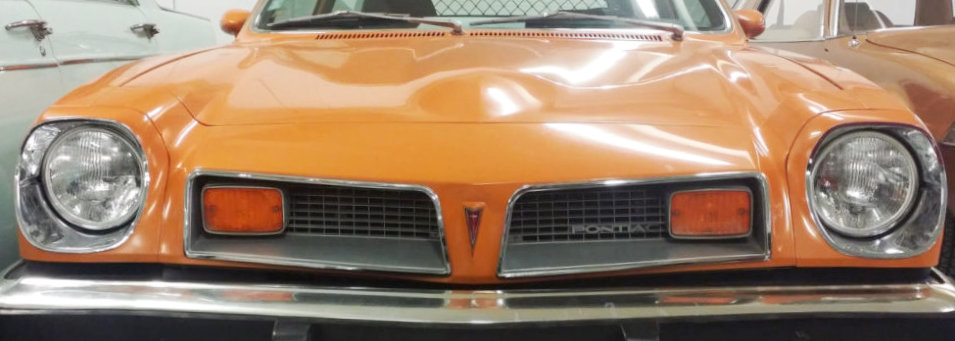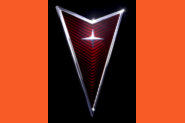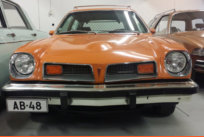












A Chevrolet Vega variant for Canadian markets

Pontiac Astre SJ Safari
Wagon - 75
The Pontiac Astre is a subcompact automobile that was
marketed by the Pontiac division of General Motors as a
rebadged variant of the Chevrolet Vega. Initially
marketed in Canada for model years 1973-1974, the Astre
debuted in the U.S. for the 1975 model year, competing
with other domestic and foreign subcompacts that
included the Mercury Bobcat and Toyota Corolla.
Built on the H-body platform, the car was available in hatchback, notchback, wagon, and panel delivery body styles. The Astre shared the aluminum-block 2.3 liter inline-four engine
panel delivery body styles. The Astre shared the aluminum-block 2.3 liter inline-four engine with the Vega through 1976, while the final 1977 models used Pontiac's all-iron 2.5 liter
with the Vega through 1976, while the final 1977 models used Pontiac's all-iron 2.5 liter inline-four engine. The Astre was cancelled with the Vega at the end of the 1977 model year,
inline-four engine. The Astre was cancelled with the Vega at the end of the 1977 model year, although the wagon continued for 1978 and 1979, rebadged as part of the Pontiac Sunbird
although the wagon continued for 1978 and 1979, rebadged as part of the Pontiac Sunbird line.
line.
Design
In 1968 GM chairman James Roche announced that General Motors would produce a new mini- car in the U.S. in two years. Pontiac's own small car program had been rejected. Not only did corporate management make the decision to enter the mini-car market, it also decided to
corporate management make the decision to enter the mini-car market, it also decided to develop the car itself. It was a corporate car, not a divisional one. Ed Cole formed a GM
develop the car itself. It was a corporate car, not a divisional one. Ed Cole formed a GM corporate design team exclusively for the Chevrolet Vega headed by William Munser, who had
corporate design team exclusively for the Chevrolet Vega headed by William Munser, who had worked on the Camaro. The Pontiac Division was given its own version of the Vega for the
worked on the Camaro. The Pontiac Division was given its own version of the Vega for the Canadian market, named Astre for the 1973 model year. U.S. Pontiac dealers finally had a
Canadian market, named Astre for the 1973 model year. U.S. Pontiac dealers finally had a subcompact to sell when the Astre made its U.S. debut for the 1975 model year.
The Astre used the Vega 140 cu in (2.3-liter) inline-four engine through 1976. The engine
subcompact to sell when the Astre made its U.S. debut for the 1975 model year.
The Astre used the Vega 140 cu in (2.3-liter) inline-four engine through 1976. The engine features an aluminum-alloy cylinder block and cast-iron cylinder head with a single overhead
features an aluminum-alloy cylinder block and cast-iron cylinder head with a single overhead camshaft (OHC). 1977 models featured Pontiac's 151 cu in (2.5-liter) inline-four engine with a
camshaft (OHC). 1977 models featured Pontiac's 151 cu in (2.5-liter) inline-four engine with a cast-iron block and head with overhead valves (OHV). Transmissions are the three- and four-
cast-iron block and head with overhead valves (OHV). Transmissions are the three- and four- speed manual, five-speed manual with overdrive (1976–1977 option) and the three-speed
speed manual, five-speed manual with overdrive (1976–1977 option) and the three-speed automatic.
automatic. The Astre has a 97.0-inch (2,460 mm) wheelbase and a 65.4-inch (1,660 mm) width. The front
The Astre has a 97.0-inch (2,460 mm) wheelbase and a 65.4-inch (1,660 mm) width. The front suspension is short and long control arms with coil springs; the rear suspension is a four-link
suspension is short and long control arms with coil springs; the rear suspension is a four-link design with coil springs. A torque-arm design rear suspension replaced the four-link design
design with coil springs. A torque-arm design rear suspension replaced the four-link design starting with the 1976 models. The Astre is a rear wheel drive vehicle with a live rear axle.
starting with the 1976 models. The Astre is a rear wheel drive vehicle with a live rear axle. Steering is of a recirculating ball type with a power assist option. The brake system features
Steering is of a recirculating ball type with a power assist option. The brake system features front disc brakes with solid rotors, and rear drum brakes. Power assist was optional starting
front disc brakes with solid rotors, and rear drum brakes. Power assist was optional starting in the 1975 model year.
in the 1975 model year.
Models and changes
The Astre features Pontiac's trademark split grill, emblems and steering wheel with an upgraded interior trim to help differentiate itself from the Chevrolet Vega. Other styling
upgraded interior trim to help differentiate itself from the Chevrolet Vega. Other styling differences compared to the Vega include — 1973 model Astres have a black-finish grill and
differences compared to the Vega include — 1973 model Astres have a black-finish grill and clear parking lamp lenses on all models, and chrome headlight bezels on non-GTs. Taillight
clear parking lamp lenses on all models, and chrome headlight bezels on non-GTs. Taillight lenses (same as the Vega) had a chrome trim piece surround. 1974-1977 models have first
lenses (same as the Vega) had a chrome trim piece surround. 1974-1977 models have first generation Firebird-styled taillights (also shared with the 1973/74 Ventura) on the Notchback
generation Firebird-styled taillights (also shared with the 1973/74 Ventura) on the Notchback and Hatchback.
The Hatchback Coupe featured a lower roofline and a fold-down rear seat. The Notchback
and Hatchback.
The Hatchback Coupe featured a lower roofline and a fold-down rear seat. The Notchback Sedan had the lowest price and is the only Vega model with an enclosed trunk. The Safari
Sedan had the lowest price and is the only Vega model with an enclosed trunk. The Safari Wagon has fixed rear-side glass and a swing-up liftgate. A Panel delivery based on the wagon
Wagon has fixed rear-side glass and a swing-up liftgate. A Panel delivery based on the wagon was sold through the 1975 model year. It has steel panels in place of the rear-side glass, and
was sold through the 1975 model year. It has steel panels in place of the rear-side glass, and an additional enclosed storage area. An auxiliary front passenger seat was optional.
an additional enclosed storage area. An auxiliary front passenger seat was optional. The SJ Hatchback and SJ Safari Wagon models feature soft nylon upholstery, cut pile
The SJ Hatchback and SJ Safari Wagon models feature soft nylon upholstery, cut pile carpeting, padded and cloth covered door panels, and a fabric headliner, plus rally
carpeting, padded and cloth covered door panels, and a fabric headliner, plus rally instruments, the higher-output two barrel engine, four-speed or automatic (over a three-
instruments, the higher-output two barrel engine, four-speed or automatic (over a three- speed manual) gearbox and radial tires. A GT package option for the hatchback and Safari
speed manual) gearbox and radial tires. A GT package option for the hatchback and Safari wagon combined the lower-line interior with the SJ's performance and handling features.
The 1974 model year brought the only major body design changes, due to revised front and
wagon combined the lower-line interior with the SJ's performance and handling features.
The 1974 model year brought the only major body design changes, due to revised front and rear 5 mph (8.0 km/h) bumper standards-A slanted header panel with a new split grill and
rear 5 mph (8.0 km/h) bumper standards-A slanted header panel with a new split grill and recessed headlamp bezels complement the larger, front 5 mph aluminum bumper. Front and
recessed headlamp bezels complement the larger, front 5 mph aluminum bumper. Front and rear license plate brackets were relocated and a larger rear 5 mph aluminum bumper was
rear license plate brackets were relocated and a larger rear 5 mph aluminum bumper was used increasing the overall length three inches compared to the 1973 models. A revised rear
used increasing the overall length three inches compared to the 1973 models. A revised rear panel on notchback and hatchback models had new Firebird-styled taillights and ventilation
panel on notchback and hatchback models had new Firebird-styled taillights and ventilation extractor grills were eliminated on trunk and hatch lids.
extractor grills were eliminated on trunk and hatch lids. The 1975 Astre, introduced in the United States September 1974, gave U.S. Pontiac dealers a
The 1975 Astre, introduced in the United States September 1974, gave U.S. Pontiac dealers a needed fuel efficient subcompact. A budget "S" series was added during 1975. More than 267
needed fuel efficient subcompact. A budget "S" series was added during 1975. More than 267 changes were made including new High-energy electronic ignition system and a catalytic
changes were made including new High-energy electronic ignition system and a catalytic converter. Power brakes and a tilt steering wheel were new options. The Astre Panel delivery
was discontinued the end of the model year.
A unique Astre package was offered in 1975. Dubbed the 'Lil Wide Track, it was the creation
converter. Power brakes and a tilt steering wheel were new options. The Astre Panel delivery
was discontinued the end of the model year.
A unique Astre package was offered in 1975. Dubbed the 'Lil Wide Track, it was the creation of Jerry Juska of Dymar to help with lackluster Astre sales. Juska took his ideas to Dave
of Jerry Juska of Dymar to help with lackluster Astre sales. Juska took his ideas to Dave Landrith of Motortown Corporation specializing in custom auto work. The package includes a
Landrith of Motortown Corporation specializing in custom auto work. The package includes a front air dam, rear spoiler, appliance wire mag rims, window louvers, a chrome exhaust tip,
front air dam, rear spoiler, appliance wire mag rims, window louvers, a chrome exhaust tip, and bright stripe decals for the hood, body sides, rear spoiler, door handles, and wheel
and bright stripe decals for the hood, body sides, rear spoiler, door handles, and wheel centers. They assembled a couple of cars in Jan. and Feb. 1975 and took pictures to local
centers. They assembled a couple of cars in Jan. and Feb. 1975 and took pictures to local Detroit dealers where the package gained acceptance. It added a little over $400 to the price
of the Astre but dealers felt the difference in looks was worth the price. Production was later
switched from an old warehouse in suburban Detroit to a factory beside the Lordstown
Detroit dealers where the package gained acceptance. It added a little over $400 to the price
of the Astre but dealers felt the difference in looks was worth the price. Production was later
switched from an old warehouse in suburban Detroit to a factory beside the Lordstown Assembly Vega/Astre plant. An estimated 3,000 Lil Wide Track Astres were ordered by
Assembly Vega/Astre plant. An estimated 3,000 Lil Wide Track Astres were ordered by dealerships. The package components were later offered as a dealer installed kit.
dealerships. The package components were later offered as a dealer installed kit. Astres were confined to a single series for 1976, but they were refined with extensive
Astres were confined to a single series for 1976, but they were refined with extensive engine, chassis, and body integrity improvements. A modest facelift included a revised grill.
engine, chassis, and body integrity improvements. A modest facelift included a revised grill. The 2.3 L engine, named Dura-built 140, received improved cooling and durability
The 2.3 L engine, named Dura-built 140, received improved cooling and durability refinements, and a five years/60,000 mile warranty. The chassis received the new Pontiac
refinements, and a five years/60,000 mile warranty. The chassis received the new Pontiac Sunbird's upgraded components including the box-section front cross-member, larger rear
Sunbird's upgraded components including the box-section front cross-member, larger rear brakes and torque-arm rear suspension, replacing the four-link design, and effectively
brakes and torque-arm rear suspension, replacing the four-link design, and effectively eliminating wheel-hop on rough roads. The body received extensive anti-rust improvements.
eliminating wheel-hop on rough roads. The body received extensive anti-rust improvements. The last-of-the-line 1977s were treated to Pontiac's new 151 cu in "Iron Duke" inline-four
The last-of-the-line 1977s were treated to Pontiac's new 151 cu in "Iron Duke" inline-four engine. Both the cylinder block and cylinder head are cast-iron. Standard in the Astre and
engine. Both the cylinder block and cylinder head are cast-iron. Standard in the Astre and Sunbird, they were the first GM vehicles to utilize the engine which was widely used into the
Sunbird, they were the first GM vehicles to utilize the engine which was widely used into the 1990s. 1977 Astre models also featured a new vertical design grill and aluminum wheels (13-
1990s. 1977 Astre models also featured a new vertical design grill and aluminum wheels (13- inch) were a new option. The "Formula" option was also introduced for the Astre's final year,
inch) were a new option. The "Formula" option was also introduced for the Astre's final year, which included the handling package, chrome valve cover, three-piece spoiler, Formula T/A
which included the handling package, chrome valve cover, three-piece spoiler, Formula T/A steering wheel and special decals.
The 1978 and '79 Pontiac Sunbird wagon was a rebranded continuation of the Astre wagon,
steering wheel and special decals.
The 1978 and '79 Pontiac Sunbird wagon was a rebranded continuation of the Astre wagon, continuing with a modified 1977 Astre grille rather than taking on the Sunbird coupes' square
continuing with a modified 1977 Astre grille rather than taking on the Sunbird coupes' square headlights and flat hood.
headlights and flat hood.
Reviews
Car and Driver in a 1975 Astre road test, said, "For $180 over the price of a Vega, the Astre features upgraded interior trim-primarily the items for which Chevrolet charges $134 in their
features upgraded interior trim-primarily the items for which Chevrolet charges $134 in their custom interior. You also have the opportunity to go one big step up in luxury if you choose
custom interior. You also have the opportunity to go one big step up in luxury if you choose the SJ line which is available in hatchback and wagon body styles."
the SJ line which is available in hatchback and wagon body styles." Car and Driver in a 1977 Astre road test, said, "The Astre is the Vega-polished and refined and
Car and Driver in a 1977 Astre road test, said, "The Astre is the Vega-polished and refined and significantly improved, but still a Vega in perhaps its ultimate state of development..It
significantly improved, but still a Vega in perhaps its ultimate state of development..It remained for Pontiac to do what Chevrolet probably should have done in the first place: the
remained for Pontiac to do what Chevrolet probably should have done in the first place: the substitution of the marvelous old Chevy II cast-iron four-cylinder econo-motor for the much-
substitution of the marvelous old Chevy II cast-iron four-cylinder econo-motor for the much- troubled aluminum-block Vega engine. Sliding in and starting the engine was a revelation
troubled aluminum-block Vega engine. Sliding in and starting the engine was a revelation because its so quiet and smooth compared to the Vega. Also the Astre's interior trim was
because its so quiet and smooth compared to the Vega. Also the Astre's interior trim was judged more plush than Vega's.
Car and Driver in its 35th anniversary issue in 1990, amusingly recalled the Astre U.S. debut:
judged more plush than Vega's.
Car and Driver in its 35th anniversary issue in 1990, amusingly recalled the Astre U.S. debut: "Detroit Fights Back - The Pontiac Astre is introduced. It's a Vega with better decals."
"Detroit Fights Back - The Pontiac Astre is introduced. It's a Vega with better decals."

1975
 Engine
2,3 litres
4 cylinders
Lenght
4,48 m
Widht
1,66 m
Engine
2,3 litres
4 cylinders
Lenght
4,48 m
Widht
1,66 m
 The collections Astre was bought
new with all available options.
The collections Astre was bought
new with all available options.






Photos mainly by Matti Kreivilä. Historical facts and technical details of the vehicles provided by Wikipedia. Movies YouTube.






